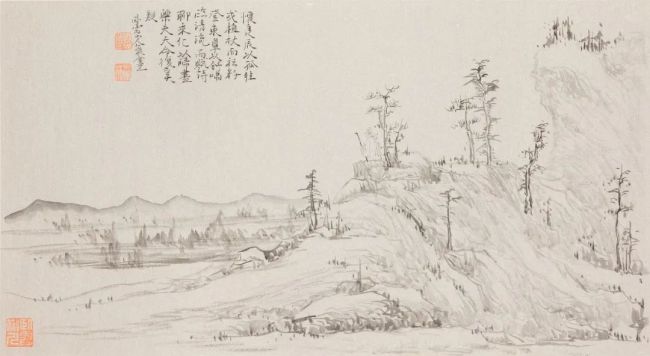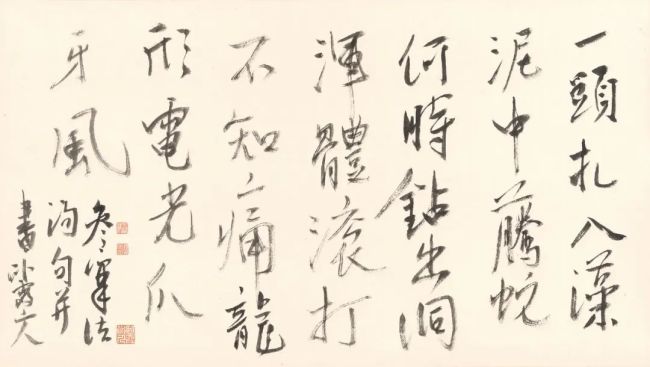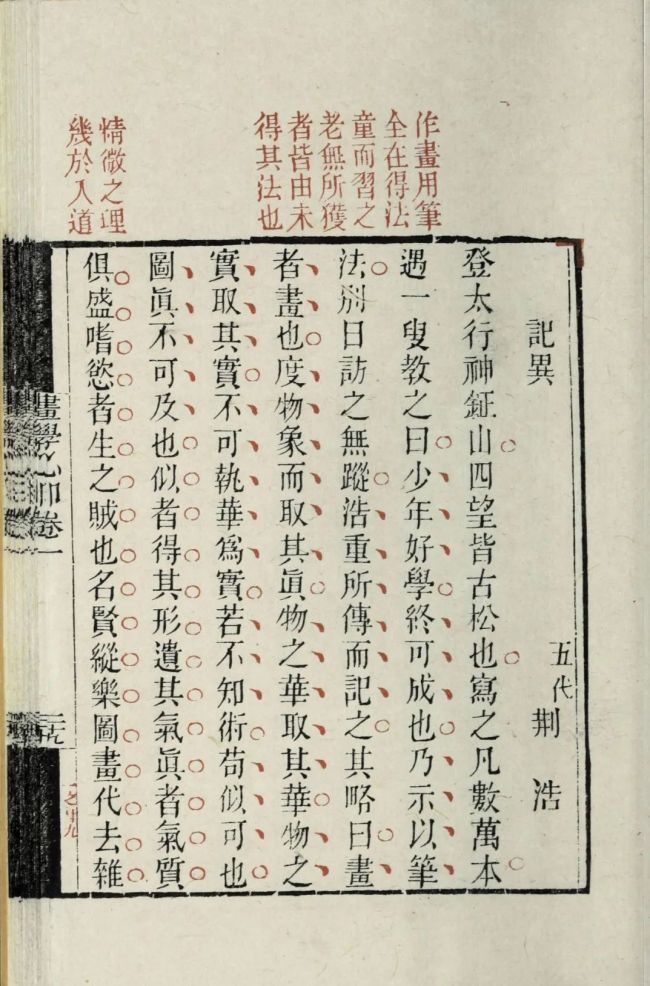比较稍晚的宋代画论郭熙的《林泉高致》中对山水境界的描述:“君子之所以爱夫山水者,其旨安在?丘园,养素所常处也;泉石,啸傲所常乐也;渔樵,隐逸所常适也;猿鹤,飞鸣所常亲也。尘嚣缰锁,此人情所常厌也。烟霞仙圣,此人情所常愿而不得见也。……然则林泉之志,烟霞之侣,梦寐在焉,耳目断绝,今得妙手郁然出之,不下堂筵,坐穷泉壑,猿声鸟啼依约在耳,山光水色滉漾夺目,此岂不快人意,实获我心哉,此世之所以贵夫画山之本意也。不此之主而轻心临之,岂不芜杂神观,溷浊清风也哉!”

陶渊明归去来兮册(其十)贝壳笺水墨 Ink on shell paper23x40cm2013
山水于五代两宋期间,即尽性、达理,亦可通情,于离世绝俗之地,舒隐逸遁世之情。这也是林海钟一种基本的心灵状态,古仁人之规范于多年来的研习之中竟一一破境,于山川中探究穷理,颐养烟霞之志,乃是安置人生的一个恰当处。伴着对《笔法记》的阅读和理解,品读林海钟数次太行山之行的满纸灿然的精彩画作,还有范厉老师所剪辑对太行山行旅的视频纪录和高津在全世界图书馆拍到的历代《笔法记》的版本,邀约我们进入到林海钟所打造的体道之所,造化之境。
(文/付晓东 2023年8曰13日于杭州)
Notes on Brushwork: Lin Haizhong’s Journey Through the Taihang Mountains
By:FuXiaodong
As the founding master of landscape painting in the Northern Song Dynasty, Jing Hao (850/856 – 923/936), a recluse in the Taihang Mountains during the Five Dynasties period, wrote Brushwork Notes, which inherited from Xie He’s “Six Methods”, and initiated the transmission of painting tradition from the Northern Song Dynasty to the Southern Song Dynasty, and was a pivotal document for the establishment of the language of brushwork and inkwork in Chinese painting, and hence the transformation of painting into ink and wash. Jing Hao was a painter who was a Confucian scholar and then a recluse, capable of poetry and good at rhetoric, thus forming a different route for the entire traditional Chinese painting style, technical path, aesthetic value and artistic spirit, which distinguished from the route of painting in red and green colors, and “became the authentic painting” (in the words of Huang Binhong). There are many versions of Brushwork Notes that have survived through history, and there are many different opinions on its authenticity, but the main viewpoint of the academic community is that the book has its origins and has been passed down in a certain way, rather than being a fabrication. Given the depth of the combination of its viewpoints with Confucian and Taoist thought, the accuracy of its experience from practice, and the influence of later generations, even if its name is removed, it is also a masterpiece that cannot be bypassed in the history of painting practice and thought. The core value presented in the book is “truth”. The evaluation criteria of “six essentials” (Qi, Yun, Thought, Scene, Stroke and Ink) and “four qualities” (spirit, subtlety, strangeness and ingeniousness), and the specific requirements of “four potentials” (sinew, flesh, bone, breath) and “two diseases” (tangible and intangible), can be deeply understood by combing with Lin Haizhong’s Journey through the Taihang Mountains as a clue and verifying them with his landscape painting practice. After the replacement of Western iconography and stylistics by AI algorithms, it is important to return to the origin point of independence of ink and landscape painting, to rethink the fundamentals issues of painting, and to find another possibility of modernity embedded in the Chinese tradition.

参笔法纸本水墨 Ink on paper34.5x61cm2016
Jing Hao’s Brushwork Notes begins with the question, “do you know brushwork?” This leads to the following three issues.
I. “Truth” and “Qi and Yun”
“Aiming at truth” and “Qi transformation theory”(气化论) are the core ideas of Jing Hao. He puts forward the idea of “pondering the images of things and taking their truth”, which means to exhaust the name and appearance of things in experience and to investigate their true nature. “Do not stick to the appearance with colors and take it as the real”: that is to say, the external form and the internal substance are not the same thing, belonging to two levels, denying the uniqueness of the meaning of the form. Rather, it is necessary to grasp the proper proportion between the real and the imaginary. We can get the truth only if we get the laws in things. “What is like gets its form and lose its Qi, and what is true prevails both in its Qi and matter.” Qi cannot stay in the level of form. It is the sum of the relationship between the becoming of things, and “truth” has the dual significance of the cosmic becoming structure and material reality. “What is true prevails both in its Qi and matter”, that is to say, “there are qualities, and interests are spiritual” (Zong Bing), Qi and interest are attached to matter, represented by paintings but not stick to them.

《画学心印》清光绪四年朱墨套印本秦祖永